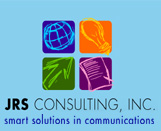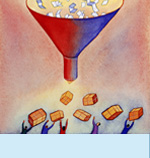


  |
||||
|
PRINTER FRIENDLY VERSION The Recipe for Exponentially Increasing Your Success: A Shot of Research, A Shot of Bourbon Q: What do you get when you mix research and bourbon? A: A public relations program that knocks the socks off your client, blows away the competition and accelerates your career a thousand fold. I'm going to let you in on a secret — I wasn't always a research person. In 1991, I was an account director at Golin/Harris International, happily managing consumer public relations programs. I used research as primarily an evaluative tool for measuring the results of publicity campaigns. But when we were invited to pitch the Jim Beam Brands Co., I faced one of the greatest challenges of my career and realized that research can be the deal-breaker that helps you create powerful, compelling communications programs. A Shot of Research Gave Us The Edge Golin/Harris was competing against two other major agencies for the Jim Beam business. Quite frankly, we were all large... experienced... and good. The question was obvious: How could we differentiate ourselves? We held numerous brainstorming and planning sessions, but somehow, the big idea didn't seem to surface. Then one day I looked around at the participants in our agency brainstorming session: mostly women in their 20's, with college and advanced degrees, who lived in trendy Chicago neighborhoods. And I thought about the typical Jim Beam drinkers at the time: males, without college degrees, who lived in rural areas. No wonder we were struggling to determine how to reach this audience! After agreeing that we needed to get a better understanding of our target bourbon drinkers, we held focus groups of Jim Beam and competitive brand users. The minute the respondents arrived for the groups, it was clear this was a smart move. These guys were obviously quite different than our account team. (Picture the Marlboro Man, minus the horse.) As we listened to the Jim Beam drinkers talk about their experiences and interests, we saw beyond the demographics to what really made these guys tick — the bonding among friends, their great interest in the outdoors and the tradition of enjoying Jim Beam Bourbon that had begun, for many, with their fathers. The focus groups allowed our team to get a much more insightful look at the target audience. Our prospective client commented during our presentation that he was impressed that we had actually interviewed his users and gone beyond "a bunch of PR people sitting around a table brainstorming and eating peanuts." In fact, the groups generated the big idea that helped Golin/Harris win the Jim Beam business and ultimately led to a program that had tripled in size by the end of our first year! But Is Qualitative Research Really Valid? What About Numbers? At JRS Consulting, we hear these questions frequently when we design qualitative and quantitative approaches for effective communications planning and measurement. And the answer is, that depends... on what you're trying to do with the research, on your overall communications program objective and on the type of insight you are seeking about your target audience. In the Jim Beam example, we had existing Simmons data that gave us numbers, i.e. the typical age of Jim Beam users, where they lived, their media preferences and their hobbies/interests. But it wasn't until we did the focus groups that we really understood how to emotionally connect with this audience and develop a program that would be meaningful to them. Of course, it's important to recognize that qualitative research has limitations. In fact, all JRS qualitative reports include the following caveat, "Focus groups seek to develop insight and direction rather than definition or precise measure. It should be noted that focus group findings are directional in nature and not necessarily projectable to a larger population due to the limited number of respondents and the restrictions in recruiting." At the same time, qualitative research is critical for identifying the emotional benefits that people associate with services and products. An emotional connection between customers and the brand builds the trust that leads to loyalty. With the connection firmly in place, loyal customer will be less likely to abandon the brand because they know they can count on it. In fact, "Does your company create an emotional bond with its customers?" is the top item on Fast Company's "10 Make-or-Break Questions" that address what a fast company is today (May 2004). In our Jim Beam example, getting out of our ivory tower and listening to the very people we were trying to reach made the difference for both developing a compelling program and showing our potential client how we were better than the competition. NOTE: Learn more about identifying emotional benefits from Jenny Schade's article, "The Ultimate Edge: Establishing Emotional Benefits," at www.jrsconsulting.net NEXT ARTICLE Jenny Schade is president of JRS Consulting, Inc., a firm that helps organizations build leading brands and efficiently attract and retain employees and customers. Subscribe to the free JRS newsletter on www.jrsconsulting.net/newsletter.html © JRS Consulting, Inc. 2007 |
 |
|||
© 2008 JRS Consulting, Inc.